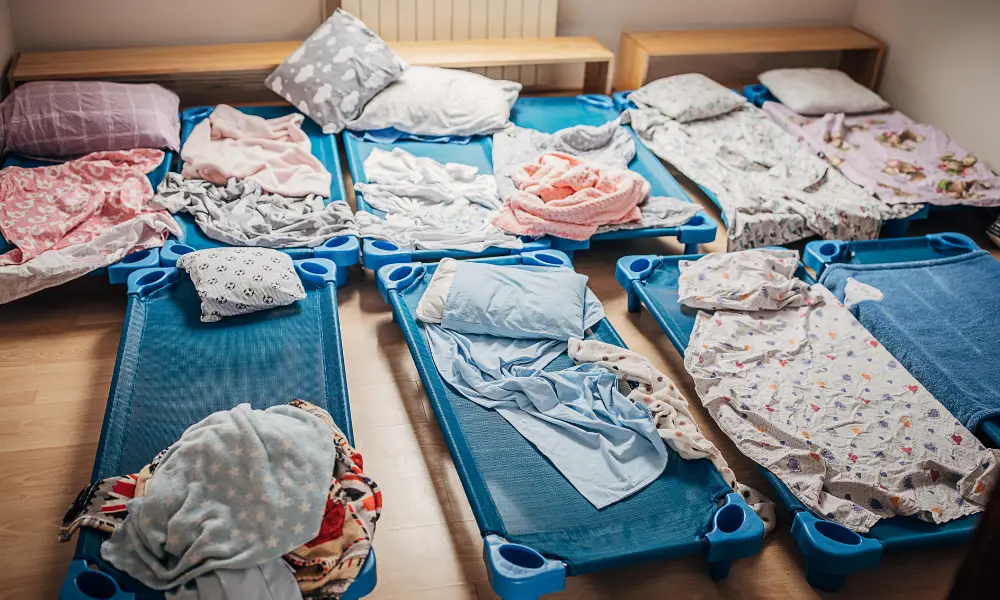17 Nap Time Tips for Daycare Centers

Published Date: 12/15/23
Jump to:
Is Nap Time Required in Daycare & Preschool?
Why Are Naps Important for Toddlers in Daycare?
Preschool & Daycare Nap Time by Age
Why Won't Children Nap at Daycare or Preschool
How to Help Children Nap at Daycare and Preschool
Daycare Nap Room Ideas and Recommendations
FAQs about Nap Time in Daycare and Preschool
As adults, we wish we had a two hour nap in the middle of the day to lay down and shut our eyes. But children...they often don't want to lay down and rest, even though their growing bodies desperately need it. Of course, you need an environment where children can nap undisturbed, so what do you do when you don't have those peaceful days when all children close their eyes the second their head hits the nap cot?

Is Nap Time Required In Daycare & Preschool?
Most states require that children in full-day daycare or preschool have a rest period during the day. Generally, that period is at least two hours and in a childcare center, often ratio laws differ during nap time, allowing teachers to take their break and have lunch.
Beyond your state’s regulations, infants, toddlers, and preschoolers need nap time to mature properly.
Why Are Naps Important for Toddlers in Daycare?
Toddlers need a lot of sleep to help their brains and bodies develop and naps are an essential part of that. When parents tell you that they want their child to stop napping, share these benefits of naps.
Naps help children learn
Studies on naps in preschool have shown that children who napped score better on memory games. Those who nap every day were even better than toddlers who nap occasionally. Preschool children who nap also have longer attention spans than those who don't.
University of California, Davis Developmental Psychologist Simona Ghetti co-authored an article on the development of memory in children and said, “The science seems to suggest that there’s a unique role of napping” in early cognitive development.

Naps improve toddler moods and behavior
Certainly you've had many days with overtired children who can't listen to anything and can't follow directions. Toddlers already lack development of self-regulation skills and the skills they do have are abandoned when they're tired. Their brains are prioritizing the need for sleep over the ability to exert any self-control. And let's be honest, even adults struggle to regulate when we're overtied so we can't expect little ones to be successfult at it when they haven't slept enought.
Naps help physical development
We know that children who don't have healthy sleep habits are at a signficantly higher risk for obesity than those who do. One exploratory study specifically looked at daytime naps in preschool found that children who didn't nap were more likely to be overweight than those who did.
How Much Nap Time Do Children Need at Daycare and Preschool?
From the physiological to the emotional benefits, napping is essential for a healthy upbringing and the number and duration of nap times are directly correlated to a child’s age.
Age | Number of Naps | Hours of Daytime Sleep |
|---|---|---|
| 0-4 months* | 3-5 naps daily | 7-9 hours of daytime sleep |
| 4-12 months* | 2-3 naps daily | 4-5 hours of daytime sleep |
| 1-2 years** | 1-2 naps daily | 2-3 hours of daytime sleep |
| 2-3 years*** | 1 nap daily | 2-3 hours of daytime sleep |
| 3-4 years*** | 1 nap daily | 1-2 hours of daytime sleep |
| 4-5 years*** | 1 nap daily | 1 hour of daytime sleep |
* Many states have regulations that require childcare providers to allow infants to sleep on demand, rather than adhere to a schedule.
** Many daycare providers segement rooms by age, either by choice or by law, and force children into a 1-nap schedule before they're ready. If you're able to, allowing two naps until a child naturally drops their second nap can benefit both you and the child. It seems disruptive in theory but you'll actually experience fewer disruptions during your day due to overtiredness.
***Parents may ask you to prevent a child from napping at daycare or preschool because naps have become disruptive to nighttime sleep. This is a tricky situation because not only are naps essential for a child's development, they're often when providers get their breaks. Additionally, if a child isn't sleeping enough at night you'll often experience challenging behaviors during the day. However, in many states you are not allowed to prevent a child from napping.
Check your regulations - you may be able to delay the start of their nap to prevent them from sleeping for too long. You'll also find that an increase in rigorous physical play leads to better naps and better nighttime sleep, so find ways of incorporating more into your day and recommend that parents provide opportunities once the child gets home.

Why Children Won't Nap at Daycare and Preschool
It's essential that children are never disciplined for not sleeping and there are many reasons why a child may not sleep, or even rest, during nap time at preschool or daycare. These include:
- A child is simply not tired at nap time
- A child is overtired and the nap window has been missed
- They are hungry, or they have food insecurity at home
- Poor sleep at home
- Reaching new developmental milestones
- A change in the amount of sleep a child needs
- Trauma at home or in their community
- Illness
- A desire for control
- They’re used to their home environment and are having trouble adjusting to a daycare setting
- They’re overstimulated

How to Help Children Nap at Daycare and Preschool
To help nap time run smoothly, we've got 17 nap time tips for childcare providers to help get infants, toddlers, and preschools calm and rested at daycare and preschool.
Daycare & Preschool Nap Time Tips
1. Set expectations for nap time
Whether you’re a daycare center or preschool with a structured schedule or a family childcare provider with a looser approach to they day, setting expectations daily is crucial for a successful nap time. If you do circle time, it’s a great opportunity to review the daily schedule and set expectations. If not, find another time during the day to set nap time expectations, like remaining quiet and staying on cots.
2. Use positive reinforcement around naps
Along with setting expectations, using positive reinforcement is key to getting children to rest quietly during nap time - or to help get the behavior you want any time. When a child lays quietly - even if it’s just for a few minutes - praise them for it and thank them. Positive reinforcement encourages the behavior you want to see happen. While you won’t see drastic changes overnight, over time a child will learn to remain quiet during rest periods. Avoid extrinsic rewards like sticker charts and treats, as they don’t work long-term.
3. Transition to nap time with a calm activity
Nap time is often right after children eat lunch and lunch tine can be loud and full of energy. If you’re struggling to get children to calm down, have children help set up their nap mats or cots, and help them settle with a quiet story time.
4. Use a nap time song
Children respond well to consistency. Select a quiet song that you play daily to indicate that nap time is starting and the children will know that it’s time to rest their bodies when they hear it.
5. Be prepared for non-nappers
It would be wonderful if every child laid down and rested quietly every single day during nap time, but children are human beings, just like adults. Some days they’ll easily drift off to sleep and some days they won’t be able to. Have a plan for children who aren’t sleeping during nap time. This may include permitting quiet activities on their nap mats or designating a space in the room where non-napping children can play quietly with specific toys.

3 Tips To Keep Your Daycare Organized
How to Handle A Bad Review of Your Daycare
When Does Marijuana Apply To Mandated Reporting?

6. Teach nap time skills during awake times
Have nap time practice during the day when you lay out expectations. Children can practice setting up their cots so there’s no confusion when nap time arrives, and then practice laying down quietly for a few moments.
7. Set up a good nap time environment
Dimming the lights, playing soft music, and using white noise can all help children relax and settle into a nap or quiet rest.
8. Have a consistent nap time schedule and routine
Children thrive on schedules and holding nap time at the same time daily can help them rest. Assign nap spots so children know exactly where to go and there's no fighting over who sleeps where when it's time to rest.
9. Be flexible
Pay attention to nap time changes throughout the year. You may find that it’s best to shift nap time by 30-60 minutes when the clocks change in November and March for daylight savings time. Children may be waking at home earlier or later based on the sunrise and that may impact how the rest at daycare. Consistency is essential but so is responding to children's changing needs.
10. Set the nap time tone
Daycare and preschool teachers may be a little frantic at the start of nap. Often cleaning up lunch, getting set up for nap, and trying to get a teacher off to break is all happening at the same time. But children pick up on your stress levels, so if you stay relaxed, it will help them relax.
11. Teach yoga and meditation techniques
Yoga and meditation techniques can help children relax and rest quietly during nap time. Teach deep breathing exercises and other ways of calming their bodies and their minds.
12. Work on proprioception activities
Proprioception is our ability to perceive our body in space - it gives us the ability to use utensils without looking in a mirror to see where our mouth is, for example. As with everything, children develop their sensory processing at different rates and some children, even those without sensory processing disorders, may be sensitive to a tag in their blanket touching them or the way their socks feel on their feet. Working on proprioception during the day may help these children settle during nap time.

13. Hide nap time distractions
While it may not always be possible to have nap time away from toys, do your best to face children away from things they may find stimulating or even use a sheet to cover up shelves during nap.
14. Give children nap time jobs & responsibilities
Children are likely to be disruptive when they’re bored and remaining on a cot for hours without sleeping is boring for most children and adults alike. Especially for older preschool children who are sleeping less, more able to follow directions, and can stay on task for longer than younger children, giving them a quiet job at nap time can keep them occupied. They can test markers to separate dried out ones, help clean out the bottoms of cubbies, sort lost and found items - be creative! There’s lots to do around daycare and preschool classrooms!
15. Incorporate more child-led activities and more rigorous physical play into your day
Children have little control over their lives and not resting during nap time could be a way of communicating they want to be in control. Reduce the number of teacher-led activities and increase the number of child-led activities to give children more autonomy and control over the day. You may find it greatly improves their naps!
In addition, tire them out with tons of rigorous play. A study found that every hour of the day children are inactive adds three minutes to the time it takes them to fall asleep
16. Teach children how naps help their bodies grow
Often we expect children to do things because we say so, with little or no explanation as to why it’s important. A science lesson on how sleep helps growing bodies can help them understand the importance of naps and make them more likely to rest quietly.
17. Give it time
A child who’s new to daycare or preschool may take several weeks or more to adjust and rest quietly during nap time. Be consistent with your approach and they’ll get the hang of it. Remember, a child attending part-time will often take longer to adjust to their new routine. Pay attention to the number of days the child has been present, not the number of weeks they’ve been enrolled.
Children aren’t robots. Their sleep needs change day-to-day and evolve as they grow and hit developmental milestones. While we all know you can’t force children to sleep, you can help limit nap time disruptions at your daycare or preschool with these tips.

Daycare Nap Room Ideas and Recommendations
Creating an optimal sleeping space will help infants, toddlers, and preschoolers fall asleep quicker and stay asleep longer. Here are some ideas for a great napping space.
Follow safe sleep practices
We hope this goes without saying, but we'll say it anyway. Ensure your home daycare, childcare center, or preschool follows safe sleep practices and all local licensing laws.
Make it quiet
Plus furnishings, carpets, and area rugs all are excellent for sound absorption. Throw pillows around the room also are great for queiting things down. If your space permits, hang decorative acoustic panels from the walls ceiling. They're easy to DIY and you can paint calming scenes on them.
Keep the nap area organized & tidy
Ensure toys and other distractions are out of view from the children. Make sure the space us uncluttered both for safety and to promote sleep. Ensure sleep cots and nap mats are easily accessible to get the napping are ready quickly.
Have the right lighting
The right lighting can help toddlers get to sleep quickly. Darken the space with window treatments and dim or turn off the lights. Keep in mind that staff still need to observe children so you'll need to have some light in the room. While more research is needed, red lights may help with melatonin production, so give it a shot in your nap space if possible.
Make the space calm
While red light may help promote sleep, red walls will have the oppsite affect. Avoid bright colors and glossy paint. Glossy paint reflects light which then stimulates the brain.
FAQs about Nap Time in Daycare and Preschool
What if a child refuses to stay quiet during nap time?
When a child refuses to stay quiet during nap, it disturbs other children. There are two things to consider when a child refuses to remain quiet during nap: 1) all behavior is communication, and 2) the child has not yet developed the empathy required to not wake other children. Work on social emotional skills with children who won’t remain quiet during nap, focusing on empathy. This will help them understand the importance of remaining quiet during nap time.
What should a childcare provider do if a baby will only sleep while being held?
As a childcare provider, you’d need to grow a dozen more arms to hold all the children who may need you at once. That said, infants have a biological need to be held and responding to their needs is critical so they develop secure bonds. If possible, you can get a baby carrier, which will allow you hands-free movement while baby sleeps. One trick is to get the baby used to the crib or pack & play during awake times. Place the child down in the crib while he or she is awake and happy and play - make silly faces, talk about how nice the crib is, play with the child, and celebrate the child being happy in the environment. As soon as you are done with this practice, remove the child from the crib - it is not to be used as a place to contain a child during awake periods. For a high needs baby, it will take a longer adjustment period, but do your best to meet the child’s emotional needs while they’re in your daycare.
Can I keep a child awake during nap time if a parent asks me to?
As a childcare provider, you’d need to grow a dozen more arms to hold all the children who may need you at once. That said, infants have a biological need to be held and responding to their needs is critical so they develop secure bonds. If possible, you can get a baby carrier, which will allow you hands-free movement while baby sleeps. One trick is to get the baby used to the crib or pack & play during awake times. Place the child down in the crib while he or she is awake and happy and play - make silly faces, talk about how nice the crib is, play with the child, and celebrate the child being happy in the environment. As soon as you are done with this practice, remove the child from the crib - it is not to be used as a place to contain a child during awake periods. For a high needs baby, it will take a longer adjustment period, but do your best to meet the child’s emotional needs while they’re in your daycare.
Q. How long is nap time in preschool?
Most preschools set aside a two-hour block for nap time. Childcare laws vary by state and determine if nap time can be shorter.
Q. What can I do if my toddler won't nap at daycare?
If your toddler is new to daycare, give it time. The power of peer pressure is mighty and they'll likely eventually fall into the nap time routine. Or you may be experiencing a nap strike. Nap strikes are when a child previously napped fine and then suddenly stops. Often parents think these phases mean it's time to drop naps but with time and consistency, your child will nap again. Other children may be overstimulated at daycare and have trouble resting or not be getting enough rigorous physical play. It's best to speak with your child's daycare provider to help identify the reason for the skipped naps and come up with a solution together.
Q. Do children nap in pre-k?
Pre-k students are usually ages 4-5. Whether or not children nap in pre-k likely depends on where you're sending them to school. If the pre-k is within a preschool, they will likely be expected to nap. If it's within a public school, it's likely that nap time will not be offered. Keep in mind that children still need naps at this age so if they don't have the opportunity to nap at school, plan to increase the amount of sleep they get overnight.
Have other nap time questions or tips? Send them to us at [email protected].
By Crystal Teegarden
 Crystal is a gentle parenting mama who loves reading, cooking, and exploring new trails with her husband and son. She is from Los Angeles but currently lives in Portland, OR where she is eating all the vegan food.
Crystal is a gentle parenting mama who loves reading, cooking, and exploring new trails with her husband and son. She is from Los Angeles but currently lives in Portland, OR where she is eating all the vegan food.
Paper Pinecone is the #1 most trusted childcare directory. Childcare providers list free so parents can find the best daycare and preschools in their area.
This post may contain affiliate links.
- stacey's blog
- Log in or register to post comments
